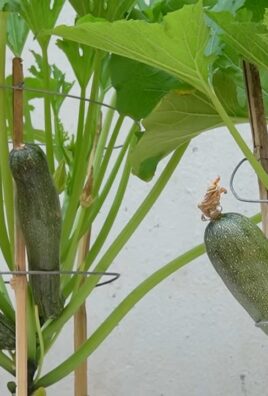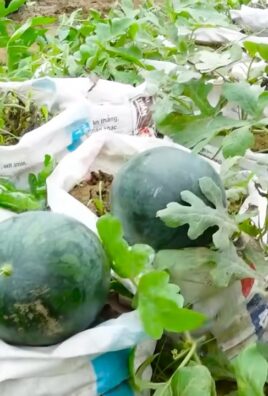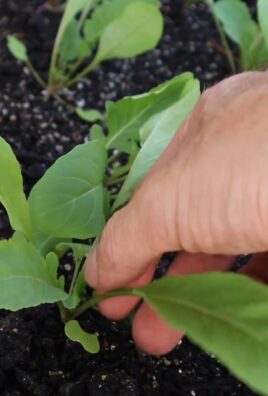Grow Bags Zucchini: Ever dreamed of harvesting plump, juicy zucchini right from your own backyard, even if you’re short on space? I know I have! For centuries, gardeners have sought innovative ways to cultivate their favorite vegetables, and the beauty of using grow bags is that it brings that dream within reach for everyone, regardless of their gardening experience or available land.
Zucchini, a summer squash with origins tracing back to the Americas, has become a staple in cuisines worldwide. But let’s face it, zucchini plants can be sprawling and demanding. That’s where the magic of grow bags comes in. This DIY guide will unlock the secrets to successfully growing zucchini in grow bags, offering a practical and space-saving solution for urban gardeners, balcony enthusiasts, and anyone looking to maximize their harvest.
I’m going to show you how to bypass common zucchini growing problems like powdery mildew and blossom end rot. Plus, you’ll learn how to choose the right grow bag size, soil mix, and watering techniques to ensure your zucchini plants thrive. Get ready to enjoy an abundance of fresh, homegrown zucchini all season long with these simple, yet effective, grow bags zucchini gardening tricks!

Growing Zucchini in Grow Bags: A Beginner’s Guide
Hey there, fellow gardening enthusiasts! I’m so excited to share my experience with growing zucchini in grow bags. It’s a fantastic way to enjoy fresh, homegrown zucchini even if you’re short on space or have less-than-ideal soil conditions. Trust me, if I can do it, you can too! I’ve learned a lot along the way, and I’m here to guide you through every step.
Why Grow Bags for Zucchini?
Before we dive into the how-to, let’s talk about why grow bags are such a great option for zucchini:
* Improved Drainage: Grow bags allow excess water to drain freely, preventing root rot, which zucchini is susceptible to.
* Better Aeration: The fabric material allows air to circulate around the roots, promoting healthy growth.
* Temperature Control: Grow bags warm up faster in the spring, giving your zucchini a head start, and they also help regulate soil temperature during hot summer months.
* Portability: You can easily move your zucchini plants to follow the sun or protect them from harsh weather.
* Space-Saving: Perfect for balconies, patios, or small gardens.
Choosing the Right Grow Bag and Variety
Okay, let’s get started! The first thing we need to do is pick the right grow bag and zucchini variety.
* Grow Bag Size: I recommend using a grow bag that’s at least 20 gallons in size. Zucchini plants get quite large and need plenty of room for their roots to spread. A 25-gallon bag is even better!
* Grow Bag Material: Fabric grow bags are the way to go. They’re breathable and allow for excellent drainage. I prefer using a thicker, more durable fabric that will last for several seasons.
* Zucchini Variety: There are tons of zucchini varieties to choose from! Some of my favorites include:
* Black Beauty: A classic, reliable variety with dark green, glossy skin.
* Costata Romanesco: A ribbed Italian heirloom with a nutty flavor.
* Golden Zucchini: A beautiful yellow zucchini that’s mild and sweet.
* Eight Ball: A round zucchini that’s perfect for stuffing.
* Bush varieties: These are more compact and well-suited for container growing.
Step-by-Step Guide to Growing Zucchini in Grow Bags
Alright, let’s get our hands dirty! Here’s a detailed guide to growing zucchini in grow bags:
1. Preparing the Grow Bag
* Choose a Location: Zucchini needs at least 6-8 hours of sunlight per day. Pick a sunny spot for your grow bag.
* Place the Grow Bag: Before you fill it, place the grow bag where you want it to stay. Once it’s full of soil, it will be heavy and difficult to move.
* Fill the Grow Bag: Use a high-quality potting mix that’s well-draining and rich in organic matter. I like to mix in some compost or aged manure for extra nutrients. Fill the grow bag almost to the top, leaving a few inches of space.
2. Planting the Zucchini
* Starting from Seed: You can start zucchini seeds indoors about 3-4 weeks before the last expected frost. Sow the seeds about 1 inch deep in small pots filled with potting mix. Keep the soil moist and warm. Once the seedlings have a few true leaves, you can transplant them into the grow bag.
* Starting with Seedlings: If you’re buying seedlings from a nursery, choose healthy plants with strong stems and vibrant green leaves.
* Planting: Dig a hole in the center of the grow bag that’s large enough to accommodate the root ball of the seedling. Gently remove the seedling from its container and place it in the hole. Backfill with potting mix and gently firm the soil around the base of the plant.
* Watering: Water the newly planted zucchini thoroughly.
3. Caring for Your Zucchini Plants
* Watering: Zucchini plants need consistent moisture, especially during hot weather. Water deeply whenever the top inch of soil feels dry to the touch. Avoid overhead watering, as this can lead to fungal diseases. I prefer to water at the base of the plant.
* Fertilizing: Zucchini is a heavy feeder, so it needs regular fertilization. Use a balanced fertilizer (like 10-10-10) every 2-3 weeks. You can also use a liquid fertilizer or compost tea.
* Mulching: Apply a layer of mulch around the base of the plant to help retain moisture, suppress weeds, and regulate soil temperature. Straw, wood chips, or shredded leaves work well.
* Pruning: Pruning isn’t usually necessary for zucchini plants, but you can remove any yellowing or damaged leaves to improve air circulation.
* Pollination: Zucchini plants have separate male and female flowers. The female flowers have a small zucchini fruit at the base, while the male flowers don’t. Bees are usually responsible for pollination, but if you’re not seeing many bees in your garden, you can hand-pollinate the flowers. To do this, simply take a male flower and gently rub its pollen onto the stigma of a female flower.
* Pest Control: Keep an eye out for common zucchini pests like squash bugs, squash vine borers, and aphids. You can use insecticidal soap or neem oil to control these pests. I also like to inspect my plants regularly and remove any pests by hand.
* Disease Prevention: Zucchini plants are susceptible to fungal diseases like powdery mildew. To prevent these diseases, make sure your plants have good air circulation, avoid overhead watering, and apply a fungicide if necessary.
4. Harvesting Your Zucchini
* Harvest Time: Zucchini is usually ready to harvest about 50-60 days after planting. The ideal size for harvesting is when the zucchini is about 6-8 inches long.
* Harvesting: Use a sharp knife or pruning shears to cut the zucchini from the plant. Be careful not to damage the plant.
* Regular Harvesting: Harvest your zucchini regularly to encourage the plant to produce more fruit. If you let the zucchini get too large, the plant will stop producing.
Troubleshooting Common Problems
Even with the best care, you might encounter some problems while growing zucchini. Here are a few common issues and how to address them:
* Yellowing Leaves: This could be caused by overwatering, underwatering, nutrient deficiencies, or pests. Check the soil moisture, fertilize your plants, and inspect them for pests.
* Blossom End Rot: This is caused by a calcium deficiency. Make sure your soil is rich in calcium and water your plants consistently. You can also add calcium to the soil by using bone meal or crushed eggshells.
* Powdery Mildew: This fungal disease appears as a white, powdery coating on the leaves. Improve air circulation, avoid overhead watering, and apply a fungicide if necessary.
* Lack of Fruit Production: This could be caused by poor pollination, nutrient deficiencies, or stress. Make sure your plants are getting enough sunlight, water, and fertilizer. You can also hand-pollinate the flowers to ensure fruit production.
Tips for Success
Here are a few extra tips to help you succeed with growing zucchini in grow bags:
* Rotate Your Crops: Don’t plant zucchini in the same spot every year. Rotate your crops to prevent soilborne diseases.
* Companion Planting: Plant zucchini with companion plants like marigolds, nasturtiums, and basil to deter pests and attract pollinators.
* Succession Planting: Plant zucchini seeds every few weeks to extend your harvest season.
* Enjoy Your Harvest: Zucchini is incredibly versatile! You can grill it, bake it, sauté it, or even shred it and add it to breads and muffins.
Growing zucchini in grow bags is a rewarding experience. With a little bit of care and attention, you can enjoy a bountiful harvest of fresh, delicious zucchini all summer long. Happy gardening!

Conclusion
So, there you have it! Growing zucchini in grow bags is not just a trend; it’s a game-changer for gardeners of all levels, especially those with limited space or challenging soil conditions. We’ve walked you through the simple steps, highlighted the benefits, and armed you with the knowledge to cultivate a thriving zucchini patch right on your patio, balcony, or even a sunny corner of your driveway.
Why is this DIY trick a must-try? Because it unlocks the potential for a bountiful harvest of delicious, versatile zucchini, regardless of your gardening experience or the limitations of your outdoor space. Imagine fresh zucchini blossoms fried to perfection, zucchini bread filling your kitchen with its warm, comforting aroma, or grilled zucchini adding a healthy and flavorful touch to your summer barbecues. All this, grown by your own hands, with minimal effort and maximum reward.
But the beauty of this method lies not only in its simplicity but also in its adaptability. Feel free to experiment with different grow bag sizes to accommodate various zucchini varieties. Consider adding companion plants like marigolds or basil to your grow bags to deter pests and attract beneficial insects. You can even try vertical gardening techniques by training your zucchini vines up a trellis or support structure, maximizing space and creating a stunning visual display.
Don’t be afraid to get creative and personalize your grow bag zucchini garden!
Think about adding a slow-release fertilizer to the soil mix for sustained nutrient delivery. Or, if you live in a particularly hot climate, consider using lighter-colored grow bags to reflect sunlight and prevent the soil from overheating. You could even explore different watering techniques, such as using a self-watering system or a soaker hose, to ensure consistent moisture levels.
The possibilities are endless, and the only limit is your imagination.
We wholeheartedly encourage you to give this DIY trick a try. It’s an incredibly rewarding experience to nurture a plant from seed to harvest, and the satisfaction of enjoying homegrown zucchini is simply unmatched. Plus, you’ll be reducing your carbon footprint by growing your own food locally.
Once you’ve embarked on your grow bag zucchini adventure, we’d love to hear about your experience! Share your tips, tricks, and triumphs in the comments section below. Let us know what varieties you’re growing, what challenges you’ve faced, and what delicious dishes you’ve created with your homegrown zucchini. Your insights will not only inspire other gardeners but also help us refine and improve this method for future generations of zucchini enthusiasts.
So, grab your grow bags, gather your seeds, and get ready to experience the joy of growing your own zucchini. Happy gardening!
Frequently Asked Questions (FAQ)
What size grow bag is best for zucchini?
The ideal grow bag size for zucchini is typically between 10 and 20 gallons. A 15-gallon grow bag offers a good balance, providing enough space for the roots to develop without being too cumbersome to move. Smaller varieties might do well in 10-gallon bags, while larger, bushier varieties will appreciate the extra room offered by a 20-gallon bag. Remember to consider the mature size of the specific zucchini variety you’re planting when choosing your grow bag.
What kind of soil should I use in my grow bag for zucchini?
Zucchini thrives in well-draining, nutrient-rich soil. A good mix would be equal parts of high-quality potting mix, compost, and perlite or vermiculite. The potting mix provides a base for the plants to grow, the compost adds essential nutrients and improves soil structure, and the perlite or vermiculite enhances drainage and aeration. Avoid using garden soil directly in your grow bags, as it can become compacted and hinder root growth.
How often should I water my zucchini plants in grow bags?
Watering frequency depends on several factors, including the weather, the size of the grow bag, and the stage of growth of the zucchini plant. Generally, you should water deeply whenever the top inch of soil feels dry to the touch. During hot, sunny weather, you may need to water daily, or even twice a day. In cooler, cloudier weather, you may only need to water every other day. Be sure to check the soil moisture regularly and adjust your watering schedule accordingly. Overwatering can lead to root rot, while underwatering can stunt growth.
How much sunlight do zucchini plants need in grow bags?
Zucchini plants are sun-loving vegetables and require at least 6-8 hours of direct sunlight per day to thrive. Choose a location for your grow bags that receives ample sunlight throughout the day. If you live in a particularly hot climate, providing some afternoon shade can help prevent the plants from overheating.
Do I need to fertilize my zucchini plants in grow bags?
Yes, zucchini plants are heavy feeders and benefit from regular fertilization. Start by incorporating a slow-release fertilizer into the soil mix at planting time. Then, supplement with a liquid fertilizer every 2-3 weeks throughout the growing season. Choose a fertilizer that is high in phosphorus and potassium, as these nutrients are essential for fruit production.
How do I prevent pests and diseases in my grow bag zucchini plants?
Prevention is key when it comes to pests and diseases. Start by using healthy, disease-free seeds or seedlings. Ensure good air circulation around your plants by spacing them adequately. Regularly inspect your plants for signs of pests or diseases, such as aphids, squash bugs, or powdery mildew. If you spot any problems, address them promptly with organic pest control methods or fungicides. Companion planting with herbs like basil or marigolds can also help deter pests.
Can I grow different varieties of zucchini in grow bags?
Absolutely! You can grow a wide variety of zucchini in grow bags, from classic green varieties like Black Beauty and Dark Green to yellow varieties like Golden Zucchini and unique varieties like Costata Romanesco. Just be sure to choose varieties that are well-suited to your climate and growing conditions.
How do I harvest zucchini from my grow bags?
Zucchini is best harvested when it is young and tender, typically when it is 6-8 inches long. Use a sharp knife or pruning shears to cut the zucchini from the plant, leaving a short stem attached. Regular harvesting encourages the plant to produce more fruit.
What can I do with my homegrown zucchini?
The possibilities are endless! Zucchini can be used in a wide variety of dishes, from savory to sweet. You can grill it, bake it, sauté it, or even eat it raw. It’s a great addition to salads, soups, stews, and stir-fries. You can also use it to make zucchini bread, muffins, fritters, and even zucchini noodles (zoodles). Get creative and experiment with different recipes to discover your favorite ways to enjoy your homegrown zucchini.
Can I overwinter my zucchini plants in grow bags?
Zucchini is an annual plant, meaning it completes its life cycle in one growing season. It typically does not survive the winter in most climates. However, you can save seeds from your zucchini to plant again the following spring.




Leave a Comment